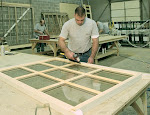
It is very exciting to see the window industry begin to embrace the value of restoring historic wood windows rather than resort to replacement. This trend towards restoration is probably driven by the limited lifespan of replacement windows and the recognition that a 75+ year-old window system can be adapted to perform at the same energy efficiency levels as replacements.
Although wood window restoration isn’t rocket science, there are many factors that can undermine the success of your project. Re-View restores thousands of wood windows per year so we have confronted many of the common pitfalls of window restoration over the past 20 years. In this blog, I am going to address the challenges of using chemical strippers to remove paint finishes.
Use of Strippers
Re-View has found chemical strippers to be very effective at the removal of multiple layers of finishes on window components. We utilize dip tanks that contain close to 50 gallons of stripping chemicals since this is the most cost effective means to remove finishes on a large number of window units. Many preservationists are critical of chemical strippers because they claim they ruin the wood. Strippers don’t ruin wood. The improper neutralization of stripping compounds from the window is what ruins the subsequent application of finishes.
It is critically important to effectively neutralize all components that are exposed to strippers. If you use the dip tank method for removal of finishes on sash, it is very important to completely disassemble the sash stiles, rails, and muntins to neutralize the window components. We find that the restoration of the mortise and tenon joints is better facilitated by separating the parts as well. Re-View will test the pH levels of the window components to confirm that proper neutralization has been performed. You want to use pH paper to make sure the wood has reached a level of at least pH7. We often will have to perform multiple neutralization applications if caustic strippers are used since they often absorbed beneath the wood surface.
There are many strippers out on the market and they fall into three different categories: caustic, solvent, and biochemical. The neutralizing techniques you will use will depend upon what type of stripper you are using. Most caustic strippers can be neutralized with a solution of vinegar and water. Some caustic strippers such as Peel Away require a proprietary neutralizer. Solvent strippers can be neutralized with mineral spirits. Many biochemical strippers can be neutralized with water. I fully recommend that you read the directions supplied by the stripper manufacturer. Unfortunately you will have to wade through many pages of health precautions to find the neutralization techniques.
If you are working on windows that were finished prior to 1978, you might have to contend with abatement issues. Proper removal and disposal of lead-based paint is critical. Many people fail to recognize that a fully stripped window that once contained lead-based paint will still be impregnated with lead. If you sand the surface of the wood, you will release lead from the wood fibers. Re-View uses specially designed downdraft sanding tables and all Federal, State, and OSHA approved safety equipment for the sanders. Also beware of asbestos fibers in glazing compound. We find that 25% of our projects have asbestos in the glazing.






You state:
ReplyDelete"Solvent strippers can be neutralized with mineral spirits."
What do you mean by this? Chemically speaking, how can mineral spirits 'neutralize' a solvent?
John
Hi, nice post. Well what can I say is that these is an interesting and very informative topic. Thanks for sharing your ideas, its not just entertaining but also gives your reader knowledge. Good blogs style too, Cheers!
ReplyDeleteHistoric Wood Window MA